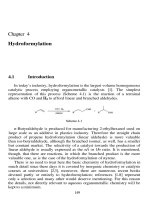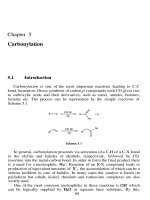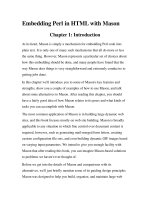Chapter 037. Palpitations pdf
Bạn đang xem bản rút gọn của tài liệu. Xem và tải ngay bản đầy đủ của tài liệu tại đây (14.37 KB, 5 trang )
Chapter 037. Palpitations
Harrison's Internal Medicine > Chapter 37. Palpitations
Palpitations: Introduction
Palpitations are extremely common among patients who present to their
caregiver and can best be defined as an intermittent "thumping," "pounding," or
"fluttering" sensation in the chest. This sensation can be either intermittent or
sustained, and either regular or irregular. Most patients interpret palpitations as an
unusual awareness of the heart beat and become especially concerned when they
sense that they have had "skipped" or "missing" heart beats. Palpitations are often
noted when the patient is quietly resting, during which time other stimuli are
minimal. Palpitations that are positional may reflect a structural process within
(e.g., atrial myxoma) or adjacent to (e.g., mediastinal mass) the heart.
Palpitations are brought about by cardiac (43%), psychiatric (31%),
miscellaneous (10%), and unknown (16%) causes, according to one large series.
Cardiac causes include premature atrial and ventricular contractions,
supraventricular and ventricular arrhythmias, mitral valve prolapse, aortic
regurgitation, and atrial myxoma. Intermittent palpitations are commonly caused
by premature atrial or ventricular contractions: the postextrasystolic beat is sensed
by the patient owing to the increase in ventricular end-diastolic dimension
following the pause in the cardiac cycle and the increased strength of contraction
(postextrasystolic potentiation) of that beat. Regular, sustained palpitations can be
caused by regular supraventricular and ventricular tachycardias (Chap. 226).
Irregular, sustained palpitations can be caused by atrial fibrillation.
It is important to note that most arrhythmias are not associated with
palpitations. In those that are, it is often useful either to ask the patient to "tap out"
the rhythm of the palpitations or to take his or her pulse while palpitations are
occurring. In general, hyperdynamic cardiovascular states caused by
catecholaminergic stimulation from exercise, stress, or pheochromocytoma can
lead to palpitations. In addition, the enlarged ventricle of aortic regurgitation and
accompanying hyperdynamic precordium frequently lead to the sensation of
palpitations. Other factors that enhance the strength of myocardial contraction,
including tobacco, caffeine, aminophylline, atropine, thyroxine, cocaine, and
amphetamines, can cause palpitations.
Psychiatric causes of palpitations include panic attack or disorder, anxiety
states, and somatization, alone or in combination. Patients with psychiatric causes
for palpitations more commonly report a longer duration of the sensation (>15
min) and other accompanying symptoms than do patients with other causes.
Among the miscellaneous causes of palpitations are included thyrotoxicosis, drugs
(see above) and ethanol, spontaneous skeletal muscle contractions of the chest
wall, pheochromocytoma, and systemic mastocytosis.
Approach to the Patient: Palpitations
The principal goal in assessing patients with palpitations is to determine if
the symptom is caused by a life-threatening arrhythmia. Patients with preexisting
coronary artery disease (CAD) or risk factors for CAD are at greatest risk for
ventricular arrhythmias as a cause for palpitations. In addition, the association of
palpitations with other symptoms suggesting hemodynamic compromise,
including syncope or lightheadedness, supports this diagnosis. Palpitations caused
by sustained tachyarrhythmias in patients with CAD can be accompanied by
angina pectoris or dyspnea. In patients with ventricular dysfunction (systolic or
diastolic), aortic stenosis, hypertrophic cardiomyopathy, or mitral stenosis, with or
without CAD, palpitations can be accompanied by dyspnea from increased left
atrial and pulmonary capillary wedge pressure.
Key features of the physical examination that will help confirm or refute
the presence of an arrhythmia as a cause for the palpitations and its adverse
hemodynamic consequences include measurement of the vital signs, assessment of
the jugular venous pressure and pulse, and auscultation of the chest and
precordium. A resting electrocardiogram can be used to document the arrhythmia.
If exertion is known to induce the arrhythmia and accompanying palpitations,
exercise electrocardiography can be used to make the diagnosis. If the arrhythmia
is sufficiently infrequent, other methods must be used, including continuous
electrocardiographic (Holter) monitoring; telephonic monitoring, through which
the patient can transmit an electrocardiographic tracing during a sensed episode;
and loop recordings (external or implantable), which can capture the
electrocardiographic event for later review.
Most patients with palpitations do not have serious arrhythmias or
underlying structural heart disease. Occasional benign atrial or ventricular
premature contractions can often be managed with beta blocker therapy if
sufficiently troubling to the patient. Palpitations incited by alcohol, tobacco, or
illicit drugs need to be managed by abstention, while those caused by
pharmacologic agents should be addressed by considering alternative therapies.
Psychiatric causes of palpitations may benefit from cognitive or
pharmacotherapies. The physician should note that palpitations are at the very
least bothersome and, on occasion, frightening to the patient. Once serious causes
for the symptom have been excluded, the patient should be reassured the
palpitations will not adversely affect his or her prognosis.
Acknowledgment
Dr. Thomas Lee authored this chapter in previous editions. Some of the
material from the 16th edition has been carried forward.
Further Readings
Abbott AV: Diagnostic approach to palpitations. Am Fam Physician
71:743, 2005 [PMID: 15742913]
Pickett CC, Zimetbaum PJ: Palpitations: A proper evaluation and approach
to effective medical therapy. Curr Cardiol Rep 7:362, 2005 [PMID: 16105492]
Weber BE, Kapoor WN: Evaluation and outcomes of patients with
palpitations. Am J Med 100:138, 1996 [PMID: 8629647]









